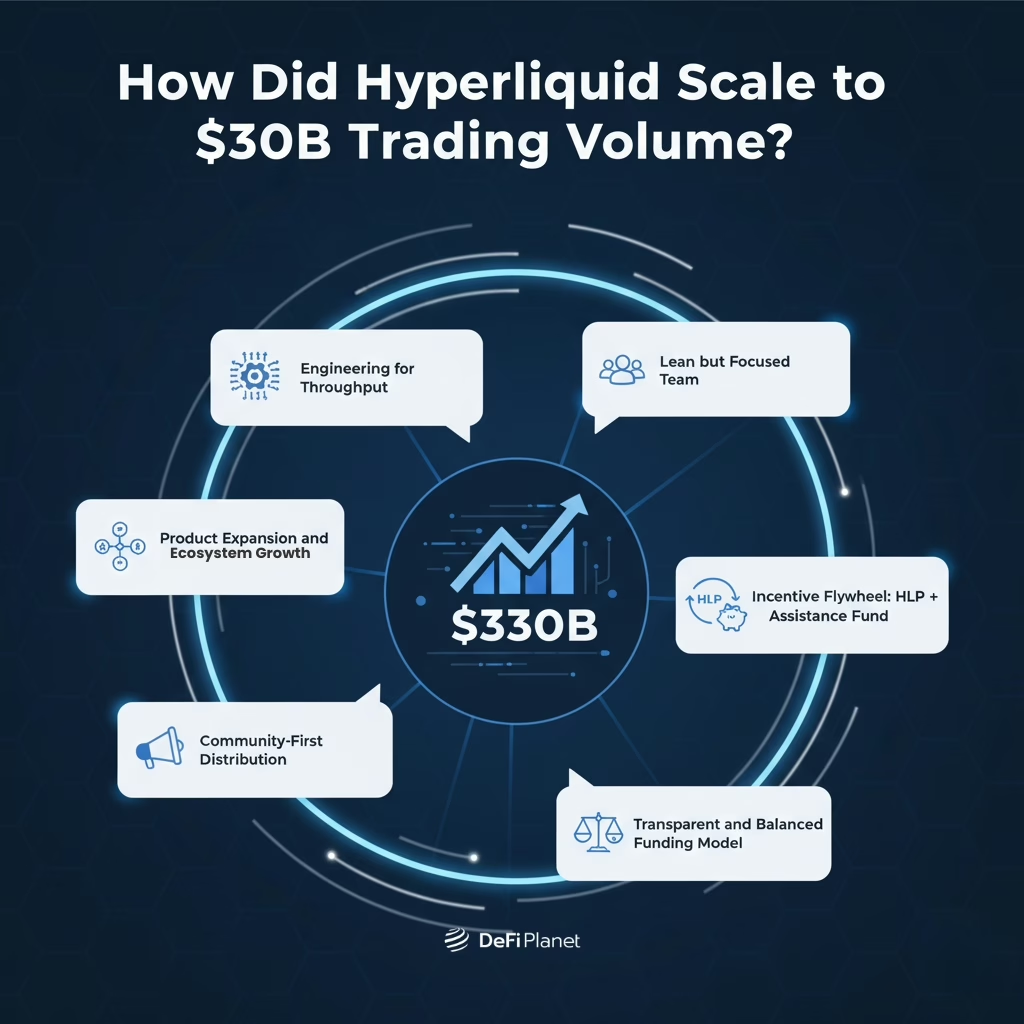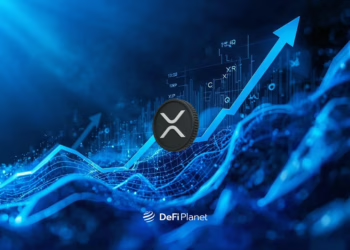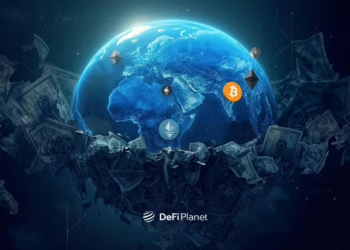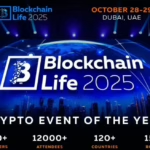Quick Breakdown
- $330B Volume With 11 Staff: In July 2025, Hyperliquid processed over $330B in trading volume, outperforming Robinhood’s combined equities and crypto flow with just an 11-person team.
- On-Chain Innovation + Incentives: Its custom Layer 1, featuring HyperCore, HyperEVM, and HyperBFT, delivers CEX-level speed while community-first tools like the HLP vault and Assistance Fund drive liquidity and adoption.
- Community and Ecosystem Growth: With grassroots token distribution, Phantom Wallet integration, and HyperEVM expansion, Hyperliquid is building a sustainable DeFi hub powered by users, not VCs.
In July 2025, Hyperliquid shocked the crypto world by processing more than $330 billion in trading volume. What made the headline even more striking was that this performance came from a tiny, 11-person team, operating a DeFi exchange that grew almost entirely outside the venture capital spotlight.
Hyperliquid is a decentralized perpetual exchange built on a custom layer 1. Its rise is more than just a story about big numbers. It highlights how lean teams, novel blockchain engineering, and community-first incentives can challenge industry giants.
Understanding how Hyperliquid trading volume pulled off such scaling strategies offers a window into the future of decentralized trading and what may separate the winners from the rest in the race to combine CEX performance with DeFi principles.
How Did Hyperliquid Scale to $330B Trading Volume?
Hyperliquid trading volume has surpassed Robinhood’s combined equities and crypto flow, so how did it scale to $330B trading volume?

Engineering for Throughput
Hyperliquid’s technical foundation is designed to deliver CEX speed with DEX trust. Instead of outsourcing matching or liquidity offchain, it keeps everything onchain, which is unusual in DeFi.
- HyperCore runs the trading engine. It manages central-limit order books, matching, margin, and liquidations entirely onchain with price–time priority. This avoids the “black box” of offchain matching engines and ensures transparency for every trade.
- HyperEVM adds Ethereum Virtual Machine (EVM) compatibility on the same blockchain. Since it shares consensus and data availability with HyperCore, third-party apps can integrate seamlessly without creating silos.
- HyperBFT, a HotStuff-inspired proof-of-stake consensus, coordinates everything. It provides fast finality and low latency while maintaining security and decentralization.
These components mean Hyperliquid can process massive trading volumes without the tradeoffs that slow down traditional DEXs. Where AMMs depend on liquidity pools, Hyperliquid runs like a real exchange but stays transparent and trustless.
Lean but Focused Team
Hyperliquid’s organizational philosophy is as important as its technology. With only 11 staff, the lean teams prioritizes precision over size.
- Selective hiring: Founder Jeff Yan stresses that bringing in the wrong person can hurt more than waiting. This keeps the culture tight-knit and aligned on execution speed.
- No venture capital: The platform is self-funded, meaning it doesn’t have to chase aggressive growth to satisfy investors. Instead, it can prioritize sustainability, transparency, and user trust.
- Rapid response culture: When an API outage on July 29, 2025 disrupted trading, the team reimbursed affected traders $1.99M within a single business day. That kind of accountability is rare in DeFi and builds credibility.
This small-team model eliminates layers of bureaucracy, enabling Hyperliquid to move faster than rivals. This helped it achieve CEX-level performance with a fraction of the resources.
Incentive Flywheel: HLP + Assistance Fund
Liquidity is the lifeblood of an exchange, and Hyperliquid designed a self-reinforcing flywheel to ensure its scaling strategy worked naturally.
- HLP Vault (Hyperliquidity Provider): Anyone can deposit capital into this onchain vault. It provides liquidity for trading and covers liquidations. Depositors share in profits and trading fees, making the market open and community-driven instead of reserved for insiders.
- Assistance Fund: 99% of protocol fees flow here and are used to buy back and burn HYPE tokens. This creates a loop: more trading volume, more fees, larger buybacks, lower token supply, stronger ecosystem incentives.
This design keeps liquidity deep without relying on private deals with professional market makers, a common weakness in other DEXs. Instead, Hyperliquid trading volume grows and strengthens its token economy in tandem.
Transparent and Balanced Funding Model
Perpetuals can be destabilized if funding mechanisms are poorly designed. Hyperliquid avoids this by keeping its system peer-to-peer, transparent, and capped.
- Funding payments are exchanged directly between traders, with the protocol itself taking no cut.
- Rates combine a fixed interest with a floating premium that tracks centralized exchange spot markets through an oracle.
- To prevent volatility spirals, rates are capped at 4% per hour, and both longs and shorts share the costs.
This balanced design keeps perpetual contract prices tightly aligned with spot markets while distributing risks fairly across traders. It avoids unsustainable “yield promises” that have hurt other DeFi platforms.
Community-First Distribution
Unlike many projects that heavily reward insiders, Hyperliquid launched with a user-first token strategy.
- In November 2024, it distributed 310 million HYPE tokens in a genesis airdrop to early users. This helped foster a strong grassroots community and positioned users as true stakeholders.
- HYPE tokens are central to the network: they’re used for staking in HyperBFT consensus, for paying gas, and for ecosystem governance
- Integration with Phantom Wallet in 2025 brought Hyperliquid’s perpetuals directly to retail users. Within weeks, this added billions in volume and tens of thousands of new users.
By putting ownership and usability in the hands of traders, Hyperliquid has built a loyal base that actively drives adoption.
Product Expansion and Ecosystem Growth
Hyperliquid hasn’t just built an exchange, it’s creating an onchain ecosystem for trading and beyond.
- The launch of HyperEVM in February 2025 unlocked general-purpose smart contracts on the same chain as the exchange. This allows wallets, vaults, and apps to build directly around Hyperliquid without friction.
- This modularity has encouraged developers to plug in, creating new trading pairs, custom vaults, and wallet integrations
- As the ecosystem grows, so do network effects, each new product strengthens the exchange’s liquidity and stickiness.
This layered expansion ensures Hyperliquid isn’t just a one-off success, but a growing hub for DeFi trading activity.
Final Takeaway
Hyperliquid’s meteoric rise offers several key lessons for crypto space. First, lean teams can adopt scaling strategies that pair with smart engineering and tight operational feedback loops. Second, on-chain innovation can deliver CEX-level performance without bloated staffing or excessive centralization. Third, community-aligned incentives can amplify adoption and liquidity without relying on outside capital.
While Hyperliquid’s model may not be universally replicable, it raises an important question for the future of crypto exchanges: could small, disciplined teams with the right technology and incentive structures challenge the dominance of traditional exchanges? The platform’s success suggests the answer could very well be yes.
Disclaimer: This article is intended solely for informational purposes and should not be considered trading or investment advice. Nothing herein should be construed as financial, legal, or tax advice. Trading or investing in cryptocurrencies carries a considerable risk of financial loss. Always conduct due diligence.
If you would like to read more articles like this, visit DeFi Planet and follow us on Twitter, LinkedIn, Facebook, Instagram, and CoinMarketCap Community.
Take control of your crypto portfolio with MARKETS PRO, DeFi Planet’s suite of analytics tools.”




















